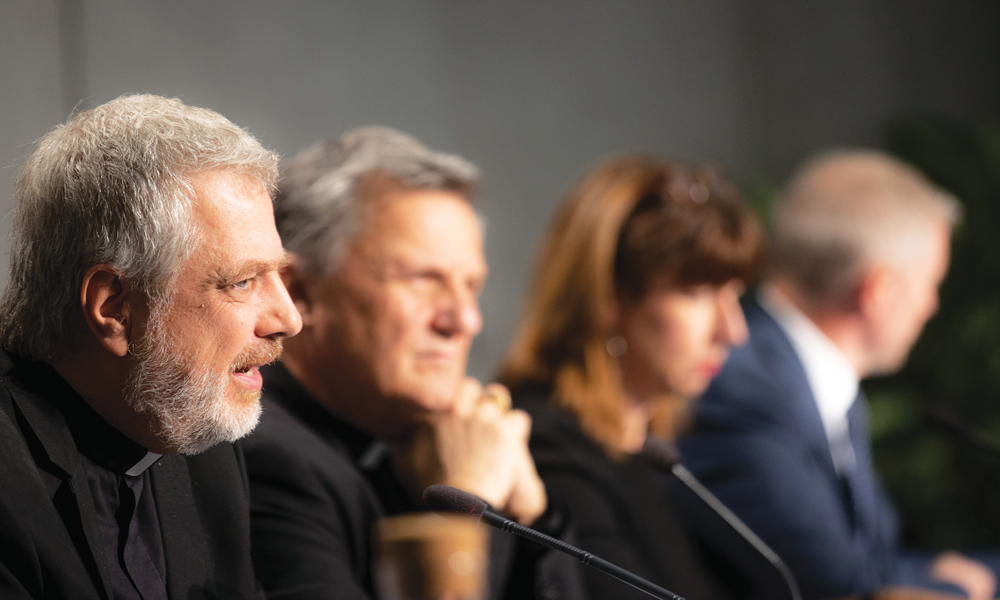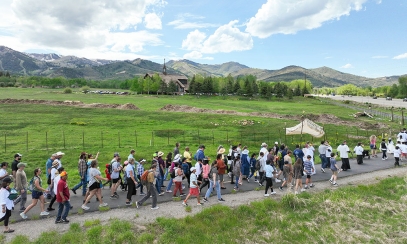
One Body: Synod on Synodality moves into final phase
In his address for the opening of the Synod in Oct. 2021, Pope Francis said: “The Synod is not a parliament or an opinion poll; the Synod is an ecclesial event and its protagonist is the Holy Spirit. If the Spirit is not present, there will be no Synod.”
In his address for the opening of the Synod in Oct. 2021, Pope Francis said: “The Synod is not a parliament or an opinion poll; the Synod is an ecclesial event and its protagonist is the Holy Spirit. If the Spirit is not present, there will be no Synod.”
The Synod on Synodality is a three-year process involving encounter, listening and discerning. Pope Francis’ goal in calling this synod was to invite all the baptized to participate in the process. The word synod comes from the Greek synodos, which has the general meaning of “walking together.”
How is this synod different?
Past synods were General Assemblies of bishops in Rome. According to the Vatican, although previous synods also began with wide consultations in the form of questionnaires, this is the first time that everyone has been directly asked to engage in an exercise of listening at the level of parishes and dioceses. Pope Francis has stressed throughout that no one should be excluded, especially those voices that have not been typically heard in past synods.
What does it mean to become a “synodal Church”? Pope Francis describes this as an opportunity to become a “listening Church” and a Church of “closeness, compassion and tender love” which better reflects the “style of God.”
The four phases of the synod
Following are the four phases of the Synod on Synodality:
- Diocesan Phase (Oct. 2021): The faithful and bishops participated in listening sessions at the local and diocesan levels, hoping to hear from voices on the margins of the Church. This phase culminated in the document, National Synthesis of the People of God in the United States of America for the Diocesan Phase of the 2021-2023 Synod.
- Episcopal Conference/Synods of Oriental Churches Phase (Aug. 2022): Reports from listening sessions in the diocesan phase were synthesized in the Episcopal Conference phase, highlighting main points to be carried out through the synodal process and where further discernment of the Church is needed.
- Continental Phase (Feb. and March 2023): A total of 12 virtual assemblies were held during February and March 2023 (7 in English, 3 in Spanish and 2 in French). The delegates (more than 900) reported greatly appreciating the listening sessions. Discernment continued in this phase to determine priorities for the Synod of Bishops in the next phase. The North American Final Document for the Continental Stage of the 2021-2024 Synod marked the end of the continental phase.
- Universal Phase (Oct. 2023 and Oct. 2024): The Synodal Assembly of Bishops (in two separate sessions) will be asked to listen deeply to the situations in which the Church lives and carries out its mission.
Three key themes from continental phase
Key themes were recognized during the Continental Assembly of North America and presented in the final document.
- Called and Gifted Through Baptism: In recognizing the dignity of all who have been baptized, every baptized person shares in the dignity of the sacrament and the responsibility of “expanding the tent,” especially reaching out to the marginalized and those who have historically had lesser roles in the Church.
- Communion with Christ and One Another: Despite growing fragmentation in the world and the Church, all the faithful are united through baptism in Christ and called to communion with one another and our Savior. Building trust through dialogue, greater inclusivity and listening are aspects that build this communion.
- Sent Forth on Mission: All the faithful, through virtue of baptism, share in the same work that Christ himself commanded: to go forth and make disciples. Proper faith formation and understanding of Catholic social teaching is important for all the baptized to understand this missionary mindset.
Priorities for Oct. 2023 gathering in Rome
The Synod Team proposed the following priorities for further consideration at the Synodal Assembly in Oct. 2023 (and Oct. 2024).
- Integration of synodal consultation in the local Churches. This would include formation both in synodality and in the spirituality of discernment.
- The challenge of welcoming those who feel excluded from participation in the life of the Church in a manner that is authentic and faithful to the Gospel and the Catholic faith weighs heavily on the hearts of our people.
- Co-responsibility. A plea for renewed consideration of the mission of all the baptized, especially a better understanding of the roles of the laity in general, and of women and young people in particular.
- Addressing the unity and communion of the Church in the midst of various kinds of polarization and division.
- A Church that goes out to the peripheries.
By the numbers
Almost 90% of the dioceses and eparchies in the United States and Canada (236/267) were represented in the continental assemblies.
931 delegates:
- 391 lay women;
- 235 lay men;
- 76 deacons;
- 148 priests;
- 77 women religious;
- 4 non-ordained men religious
Participation
Contributions received from 112 out of 114 Episcopal Conferences
Contributions received from all 15 Oriental Catholic Churches
Reflections received from 17 out of 23 dicasteries of the Roman Curia



